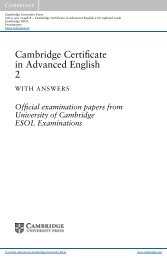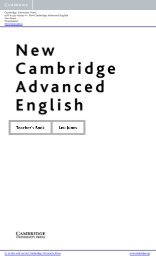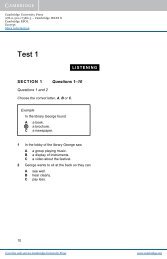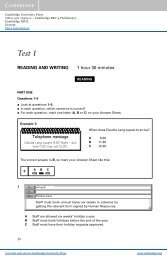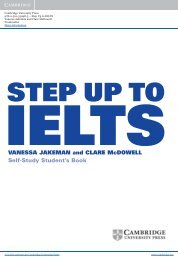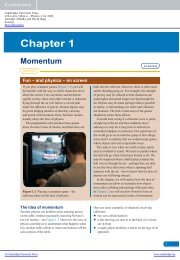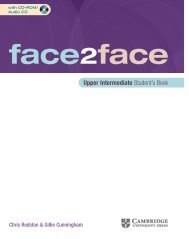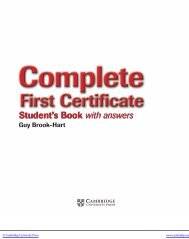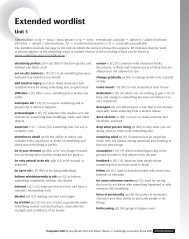Skills for Study Level 2 Teacher's Book - Cambridge University Press
Skills for Study Level 2 Teacher's Book - Cambridge University Press
Skills for Study Level 2 Teacher's Book - Cambridge University Press
You also want an ePaper? Increase the reach of your titles
YUMPU automatically turns print PDFs into web optimized ePapers that Google loves.
Assignment 2Note: The unit task <strong>for</strong> this assignment can work in one of two ways:1 Where equipment exists to conduct the experimentUnit Task Part AStudents watch a video of a demonstration of the experiment (Video SS2-2A1 –Part A), be<strong>for</strong>e conducting the actual experiment themselves.Unit Task Part BStudents read through a complete lab instruction <strong>for</strong> the experiment.Unit Task Part CStudents complete the experiment themselves.Unit Task Part DStudents create a poster <strong>for</strong> their results.Unit Task Part EStudents write a full lab report <strong>for</strong> the experiment.2 Where there is no equipment to conduct the experimentAll parts are the same as above, except Part C. If there is no equipment to conductthe experiment, then students watch a video of the experiment (Video SS2-2A1 –Part B) in which readings are taken <strong>for</strong> three different beaker sizes. They can usethis data to complete a logbook, and then create a poster and lab report from it.Note that the video recording is of the experiment, though the results recorded inthe experiment do not accurately match published data <strong>for</strong> the refractive index ofwater. This should be used to in<strong>for</strong>m the discussion or limitations section of thelogbook and report.aAnswers1 Its direction of movement changes (or ‘bends’).2 Passing across a boundary between one medium and another (e.g. betweenair and water).3 It appears to be in a different position (higher in the water) than it really is.4 Real depth is the actual depth of the object; apparent depth is what it appearsto be when refracted. The refracted ‘apparent’ depth is what you see whenyou look into the water from above.www.cambridge.org/elt/<strong>for</strong>studybcStudents watch the video demonstration of the experiment.Group discussion. Note: The text following activity c gives basic theoreticalbackground <strong>for</strong> the experiment.Note: Ask students to turn to the checklist on p.241 and read the tips relating toUnit 2 Part A. Encourage students to put these tips into practice in their studiesfrom now on. Tell them they will be asked to report back on this in a future lesson.Unit 2 Part A ∙ Understanding spoken in<strong>for</strong>mation 44



